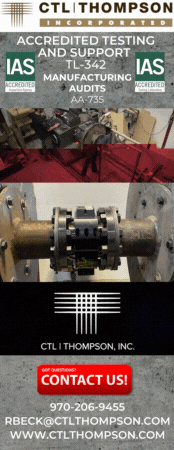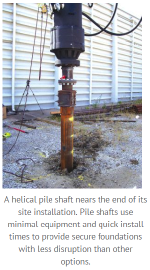

Copyright © 2011-24 Helical Pile World, LLC. All Rights Reserved.
Home | Engineers | Manufacturers | Installation Contractors | News | Technical Advisors | Contact Us







How to Standardize the Installation of Helical Piles

Note: This is a reprint of an article originally published by Structure Magazine
Helical piles are subject to special inspections, similar to deep foundations, but engineers have several choices when looking for the best way to install them. Currently, there are no standards for the installation of helical piles. However, helical piles should be installed and inspected in accordance with all relevant requirements listed in the governing building code.
Through the International Society of Helical Foundations program, engineers can obtain certification that allows them to provide inspection services. However, the engineering community would collectively benefit from the establishment of universal standards for installing helical piles to reduce the likelihood of building damage caused by pile failure. Pile failure may occur due to incorrect installation techniques or other unforeseen circumstances.
Standards establish qualitative and quantitative values and are integral to the field of civil engineering. An accepted standard for helical pile installation gives the engineer additional assurance that the pile will perform as intended by the design.
Adopting this kind of measure may help mitigate risks such as structural damage resulting from liquefaction. Liquefaction occurs when a seismic event causes shaking, leading to soils acting more like liquids than solids. If the soil supporting the foundation of a building liquefies, the foundation is much more susceptible to extensive settlement, uniform and differential. These settlements may lead to significant structural damage, and in some cases, collapse.
Obstacles to Standardization
The primary obstacle to overcome when addressing standardization is – not surprisingly – cost. For example, it is generally accepted that the risk of the occurrence of liquefaction and conditions like it are too low to justify the costs of prevention. Many believe that adhering to certain helical pile installation standards would no doubt increase construction costs.
However, the increase in construction costs can occur if contractors are not supplied with standardized piles. Sites that hire contractors unaware of pile standards could see mounting change orders, overdesigns that camouflage pile issues, or piles being installed too deep into a foundation. These problems, and others, can send construction into cost overruns.
While a decrease in liquefaction risk is indeed a benefit, some may debate how valuable installation standards would be. Fortunately, specific tests and analysis can determine whether a residential area is at a high risk for foundation issues. A soil analysis, for instance, can reveal that certain types of soil, such as clay-free deposits of sand and silt, are the most susceptible to damage, with that risk intensifying in areas that are most prone to seismic activity.
Piles are a long-term investment, with cracks in foundations and other issues possibly taking years to manifest. Cost concerns are a more immediate concern, ones that can be addressed by making standardized piles a priority early in the construction process.
Standardization Metrics
Contractors and site managers looking for properly calibrated piles should put the following strategies in place.
1. Update torque indicators – Installation requires a torque indicator that directly measures torque. This requirement ensures that torque readings are accurate. Moreover, because torque is used to estimate the ultimate capacity of the helical pile, such a standard would result in more reliable estimates.
2. Work with a qualified installation inspector – Working with someone who provides inspection services is one option. However, even if the project is not subject to special inspection, it is still important to use a third party to make sure everything is as it should be. The International Society of Helical Foundations (ISHF) provides certifications for any inspector interested in being credentialed. Inspectors assess the following variables to make sure a pile is up to standards:
• Pile location and attachment method
• The pile shaft’s minimum size and type
• Pile’s minimum depth
• Required load-per-pile value and other safety factors
• Minimum installation torque based on accepted torque correlation factors listed in ICC-ES AC358 or ESR-2794
Certified parties are trained in the proper means and methods of installation, including risk assessment. Hiring an inspector educated on installation standards and equipment specs can keep the building process as efficient as possible.
3. Complete installation logs – The installation contractor should complete installation logs for the specific project. Installation logs contain information obtained during drilling such as torque, depth, and more. As-built plans for the construction project should include any logs created during construction. This ensures that each pile is installed to the minimum torque/capacity and depth in accordance with project construction documents.
4. Rate of penetration – The majority of helix plates have a 3-inch pitch. The helix pitch is the distance between the leading edge and trailing edge of the helix plate. When the helical pile is installed, it should advance into the ground approximately one pitch per revolution.
The acceptable margin is between 2½ and 3 inches per revolution. If the helical pile is not advancing at the proper pace of one pitch per revolution, it is acting more like an auger and disturbing the soil, which can directly contribute to the risk of pile failure. Helical piles are designed to be displacement piles that advance through the soil with minimal disturbance, so note that torque correlation to capacity is not valid for a helical pile that does not advance normally. Helical piles can stop advancing if they encounter obstructions or very dense soil. When that happens, use a load test to determine the capacity of the pile accurately.
Standardizing the practice of helical pile installation is an integral part of mitigating the risk of problems like liquefaction.
Minimum material standards help ensure helical piles manufactured by different companies meet basic requirements for strength, weldability, toughness, and corrosion protection. Most helical pile manufacturing standards require the use of structural-grade steel for both the helix plates and the central shaft. In much the same way, standardizing pile installation ensures installation is done properly.
Gary L. Seider, P.E., is engineering manager of CHANCE® Civil and Utility Helical Products. Hubbell Power Systems Inc.manufactures a wide array of transmission, distribution, substation, OEM, and telecommunication products used by utilities.
With four U.S. patents and more than 40 years of industry experience, Seider oversees the company’s civil construction and utility application/project engineering staff. His team assists owners, engineers, and contractors with technical assistance, guidance, and recommendations for the proper use of CHANCE Helical Anchors and piles and Atlas Resistance® products.
December, 2017
by Gary L. Seider, P.E.
